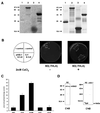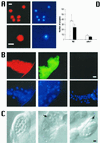Calcineurin, a calcium/calmodulin-dependent protein phosphatase, is involved in movement, fertility, egg laying, and growth in Caenorhabditis elegans
- PMID: 12221132
- PMCID: PMC124158
- DOI: 10.1091/mbc.e02-01-0005
Calcineurin, a calcium/calmodulin-dependent protein phosphatase, is involved in movement, fertility, egg laying, and growth in Caenorhabditis elegans
Abstract
Calcineurin is a Ca(2+)-calmodulin-dependent serine/threonine protein phosphatase that has been implicated in various signaling pathways. Here we report the identification and characterization of calcineurin genes in Caenorhabditis elegans (cna-1 and cnb-1), which share high homology with Drosophila and mammalian calcineurin genes. C. elegans calcineurin binds calcium and functions as a heterodimeric protein phosphatase establishing its biochemical conservation in the nematode. Calcineurin is expressed in hypodermal seam cells, body-wall muscle, vulva muscle, neuronal cells, and in sperm and the spermatheca. cnb-1 mutants showed pleiotropic defects including lethargic movement and delayed egg-laying. Interestingly, these characteristic defects resembled phenotypes observed in gain-of-function mutants of unc-43/Ca(2+)-calmodulin-dependent protein kinase II (CaMKII) and goa-1/G(o)-protein alpha-subunit. Double mutants of cnb-1 and unc-43(gf) displayed an apparent synergistic severity of movement and egg-laying defects, suggesting that calcineurin may have an antagonistic role in CaMKII-regulated phosphorylation signaling pathways in C. elegans.
Figures







References
-
- Aitken A, Cohen P, Santikarn S, Williams DH, Calder AG, Smith A, Klee CB. Identification of the NH2-terminal locking group of calcineurin B as myristic acid. FEBS Lett. 1982;150:314–318. - PubMed
-
- Arduengo PM, Appleberry OK, Chuang P, L'Hernault SW. The presenilin protein family member SPE-4 localizes to an ER/Golgi derived organelle and is required for proper cytoplasmic partitioning during Caenorhabditis elegans spermatogenesis. J Cell Sci. 1998;111:3645–3654. - PubMed
-
- Barstead RJ. Reverse genetics. In: Hope IA, editor. C. elegans: A Practical Approach. Oxford, UK: Oxford University Press Inc.; 1999. pp. 97–118.
-
- Bikah G, Pogue-Caley RR, McHeyzer-Williams LJ, McHeyzer-Williams MG. Regulating T helper cell immunity through antigen responsiveness and calcium entry. Nat Immunol. 2000;1:402–412. - PubMed
Publication types
MeSH terms
Substances
LinkOut - more resources
Full Text Sources
Molecular Biology Databases
Miscellaneous

